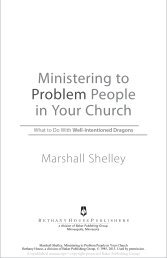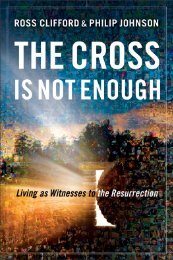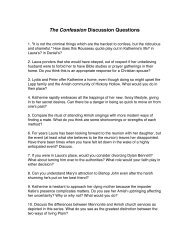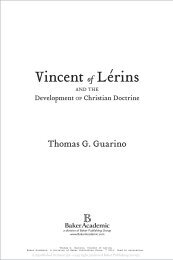Graceful EvanGElism - Baker Publishing Group
Graceful EvanGElism - Baker Publishing Group
Graceful EvanGElism - Baker Publishing Group
Create successful ePaper yourself
Turn your PDF publications into a flip-book with our unique Google optimized e-Paper software.
Gracef u lEvangelismChristian Witnessin a Complex WorldFrances S. AdeneyKFrances S. Adeney, <strong>Graceful</strong> Evangelism: Christian Witness in a Complex World,<strong>Baker</strong> Academic, a division of <strong>Baker</strong> <strong>Publishing</strong> <strong>Group</strong>, © 2010. Used by permission.
© 2010 by Frances S. AdeneyPublished by <strong>Baker</strong> Academica division of <strong>Baker</strong> <strong>Publishing</strong> <strong>Group</strong>P.O. Box 6287, Grand Rapids, MI 49516-6287www.bakeracademic.comPrinted in the United States of AmericaAll rights reserved. No part of this publication may be reproduced, stored in a retrieval system, ortransmitted in any form or by any means—for example, electronic, photocopy, recording—without theprior written permission of the publisher. The only exception is brief quotations in printed reviews.Library of Congress Cataloging-in-Publication DataAdeney, Frances S.<strong>Graceful</strong> evangelism : Christian witness in a complex world / Frances S. Adeney.p. cm.Includes bibliographical references and index.ISBN 978-0-8010-3185-4 (pbk.)1. Evangelistic work. 2. Missions. 3. Christianity and culture. I. Title.BV3790.A34 2010269 .2—dc22 2010024422Unless otherwise indicated, Scripture quotations are from the HOLY BIBLE, NEW INTERNATIONALVERSION®. NIV®. Copyright © 1973, 1978, 1984 by International Bible Society. Used by permissionof Zondervan. All rights reserved.Scripture quotations labeled NRSV are from the New Revised Standard Version of the Bible, copyright© 1989, by the Division of Christian Education of the National Council of the Churches of Christ inthe United States of America. Used by permission. All rights reserved.10 11 12 13 14 15 16 7 6 5 4 3 2 1Frances S. Adeney, <strong>Graceful</strong> Evangelism: Christian Witness in a Complex World,<strong>Baker</strong> Academic, a division of <strong>Baker</strong> <strong>Publishing</strong> <strong>Group</strong>, © 2010. Used by permission.
viiiContents13. Changes: New Movements and Institutional Re-visionings 15214. Seeing through Their Eyes: A Spiral of KnowledgeAcquisition 16115. Radical Habits: Practices for Evangelism Today 174Appendix: Constructing a Congregational Timeline 187Bibliography 191Index 201Frances S. Adeney, <strong>Graceful</strong> Evangelism: Christian Witness in a Complex World,<strong>Baker</strong> Academic, a division of <strong>Baker</strong> <strong>Publishing</strong> <strong>Group</strong>, © 2010. Used by permission.
IntroductionWhat This Book Is AboutThe word evangelism evokes strong reactions from Christians and non-Christiansin American society today. To many Christians it is a word full of hope.Evangelism is the way to spread the good news that Jesus Christ came intothe world to save us. Evangelism is the way to fulfill Jesus’s injunction to “gointo all the world and preach the good news to all creation” (Mark 16:15). Itis our mandate, and we should pursue it vigorously.To other Christians evangelism is “the E word.” Evangelism is the way toalienate non-Christians and embarrass the church. Evangelism is an outdatedway of announcing that Jesus Christ came into the world to inaugurate thekingdom of God. The church should find other ways to demonstrate thepaths of justice that Jesus came to show us. After all, when Jesus announcedhis ministry in the synagogue, he focused on preaching good news to thepoor, proclaiming freedom to the captives, and releasing the oppressed (Luke4:16–19).To some non-Christians evangelism is the way superreligious Christians pushtheir views onto others with equally valid religions and ways of understandingthe world. To others evangelism is a way some people protect themselvesfrom the harsh realities of a world where every person looks out for his orher own interests, where resources are grabbed by those who can get them,and where political wrangling often gives way to open conflict. To still othersevangelism is an irritating way people who haven’t kept up with the times tryto get others to follow an outmoded religious tradition.How did we get to this impasse? Conflict about evangelism—what it is,whether we should do it, how to go about it, what results we seek—is dividingour churches. Where did this conflict come from, and how can we addressxiFrances S. Adeney, <strong>Graceful</strong> Evangelism: Christian Witness in a Complex World,<strong>Baker</strong> Academic, a division of <strong>Baker</strong> <strong>Publishing</strong> <strong>Group</strong>, © 2010. Used by permission.
xiiIntroductionit? The battle among views of evangelism rages and exacts a toll from congregationsand denominations as they argue over definitions and strategiesof inviting others to follow the Christian way. Should the church attempt toevangelize around the world, or should we concentrate on our local situation?Should we try to bring people of other religions to Christ, or should weaffirm the religions of others? Should congregations try to grow numerically,or should we nurture our life together and hope that others will be attractedto the church?In the wider society, the battle takes the form of arguing over religion inthe public sphere, including debate about prayer in schools, posting the TenCommandments in high school hallways, and announcing Christian holidaysin schools, shopping malls, or town squares. To protect freedom of religion,our society is moving away from specific Christian references about Christmas,for example, to more general ideas that don’t push Christ as “the reason forthe season.” Coke ads replace Christian symbols with snowflakes, “MerryChristmas” becomes “Happy Holidays,” and Tiny Tim’s famous line fromCharles Dickens’s Christmas Carol morphs from “God bless us every one”to “Bless us every one” on street banners in San Francisco. There are goodreasons to protect people from having religious views foisted upon them andto be careful not to offend the religious sensibilities of others. But Christianevangelism no longer has the cultural support of general consensus andstruggles to find a fit in our pluralistic society.This book attempts to assess this situation and move toward a more gracefulapproach to evangelism. We will analyze the past, take stock of the presentsituation in evangelism, and find a way forward—a way that will reduceconflict and infuse energy into practices of Christian evangelism. We beginin chapter 1 by looking at some contemporary definitions of evangelism—definitions that bring people together and definitions that divide. We examinethe inclusive definitions of church councils and denominations, both evangelicaland ecumenical. We look at definitions of evangelism that have grown outof people’s lives and their actions. How we define evangelism influences wayswe are likely to cooperate and compete with other churches, denominations,and mission organizations. As times and circumstances change, definitions ofevangelism are reformed. New alliances of Christians are formed around thosechanging definitions. Sometimes new ways of understanding evangelism andnew configurations of organizations working on evangelism lead to conflicts.Those conflicts arise not only from changing definitions of evangelism butfrom our history.Part 1 of this book deals with evangelism as shaped by biblical and historicalmodels. It asks the question: “Where did we come from?” Where have we comefrom as a church, and as Christians who love God and want to share God’slove with others? Has evangelism always been understood in the ways that wein American society today understand it? How has the church navigated theFrances S. Adeney, <strong>Graceful</strong> Evangelism: Christian Witness in a Complex World,<strong>Baker</strong> Academic, a division of <strong>Baker</strong> <strong>Publishing</strong> <strong>Group</strong>, © 2010. Used by permission.
Introductionxiiiissues of plurality, conflicts of interest, and diverging theologies of evangelismin the past? We will examine patterns of evangelism used in the church overthe centuries. We will focus particularly on crucial transitions in the waysthe church has responded to the surrounding culture—the Reformation, theGreat Awakenings, the nineteenth-century worldwide mission movement,and the fundamentalist/modernist controversy in the early twentieth century.Understanding the past helps us recognize where our own views came fromand how they might be reordered to address current situations and fosterfuture possibilities.Chapter 2 examines five biblical models of evangelism. During Jesus’s lifetimehe showed again and again what it meant to evangelize. He spoke wordsof hope; he declared a new day; he insisted that the way to God was throughhim. Jesus himself is a model for evangelism. As we follow the paths he walkedduring his life, we will become light to the world. Relieving oppression as adeclaration of Christian faith is another biblical model of evangelism. Jesusstood up in the temple and declared that his mission in life was to loosen thebonds of oppression, heal the lame, and give sight to the blind. For Jesus,declaring the time of salvation meant changing oppressive structures andbringing healing to the world. A third model—the Great Commission—findsits source in words that Jesus reportedly said after his death and before hisascension into heaven. He charged his disciples to follow him in preaching,teaching, and calling all nations to follow his way. The apostle Paul adds anothermodel to this list of ways to evangelize when he instructs Christians tolive their daily lives as a witness to the love of God. Finally, the apostle Peterreminds Christians to be ready to give an answer to anyone who asks why theylive with hope in a world filled with suffering. These five biblical models eachresult in different approaches to evangelism.In chapter 3, we look at how these biblical models were carried out throughthe centuries that followed. Evangelism began in a persecuted church, but itsshape evolved with changing situations. New Testament models were adaptedand transformed by the church fathers. Evangelism of a different kind waspracticed by monastics in the fourth and fifth centuries. Medieval modes developedas the church ascended to a place of power in European society. TheReformation saw renewal and a changing focus on what it meant to live one’slife as a witness to Christ. Modern philosophical frameworks have influencedevangelism, and colonial expansion took Christian witness in new directions.Today various liberation and contextual models address Christian witness ina time of postmodern thinking and globalization.Current denominational and congregational conflicts about evangelismcan be understood only against the backdrop of the history of the Westernmissionary movement of the nineteenth century. Chapter 4 takes a more indepthlook at nineteenth-century models of evangelism, particularly in theAmerican context. As we look back two hundred years, we see changes in theFrances S. Adeney, <strong>Graceful</strong> Evangelism: Christian Witness in a Complex World,<strong>Baker</strong> Academic, a division of <strong>Baker</strong> <strong>Publishing</strong> <strong>Group</strong>, © 2010. Used by permission.
xivIntroductionshape and scope of evangelism and its relation to the role of Christianity inAmerica. We see differences in the way denominations understood and practicedevangelism, in the United States and in other countries. We see differentresults in various locations.As we get a grasp on where we have come from, we begin to better understandthe complex situations we face today. Part 2 of the book is devotedto the question: “Where are we now?” What concepts of evangelism guideour thinking, and what emotional responses does the word evoke for varioussectors of society? We will examine where the real conflicts are and outlineareas of compatibility among varying views. We will look at the situationof churches and analyze some current theologies of evangelism that deepencongregational life and foster unity in denominations. We will look at thediversities of culture in the United States and ask what theologies and strategiesof evangelism might fit into those diverse settings.Chapter 5 begins by outlining the situation for evangelism in the twenty-firstcentury, again from an American perspective. A world of cultural diversity andreligious pluralism confronts a church that is no longer the dominant voice inpublic life that it may have been a century ago. Philosophical understandingsof relativism and the limited nature of all knowledge have influenced viewsof Christian faith. Postcolonial critiques of Christian mission cause us totake seriously the potential harm some approaches to evangelism may have incertain contexts. The fundamentalist/modernist controversy, rather than ending,has taken new forms—forms that pit Christians with different theologiesof evangelism against each other. Finally, the mishandling of evangelism bycharlatans and well-meaning but naive proponents of wealth through Christianfaith have turned some Christians away from doing evangelism in anyform. This chapter addresses each of those issues, finding that they yield bothpositive and negative results for evangelism.Christian evangelism links us to the worldwide church. Chapter 6 describeshow mission trends around the world influence evangelism patterns in theUnited States. The growth of the church in Africa and Latin America has producedmissionary activities from those continents to the United States, Asia,and Europe. An increased focus on national church leadership in countriesthat have previously been “mission fields” of the West has resulted in fewermissionaries going to those places. A decline in support for US-based denominationalmissions has corresponded with a growth in congregationally basedmission and evangelism efforts. The recognition of women’s leadership rolesin evangelism and mission has also changed the face of Christian evangelism.Those changes are reordering, refocusing, and realigning US mission effortsaround the world.Addressing today’s mission trends along with our history results in a numberof contemporary theologies of evangelism, the topic of chapter 7. Forsome Protestants, proclamation—preaching the Word—takes a central placeFrances S. Adeney, <strong>Graceful</strong> Evangelism: Christian Witness in a Complex World,<strong>Baker</strong> Academic, a division of <strong>Baker</strong> <strong>Publishing</strong> <strong>Group</strong>, © 2010. Used by permission.
Introductionxvin approaches to evangelism. For others, justice and service have become keyingredients to evangelism and mission. Some Catholic churches take a “thresholdapproach,” sharing Christianity with anyone who crosses the thresholdof the church building. Orthodox churches evangelize by their presence in acommunity proclaiming the gospel through performing liturgical services. Aliturgical approach to evangelism claims that the worship of the congregationis, in and of itself, evangelism. To others, welcoming all into the communityas part of the human family speaks eloquently of God’s love for the world.Monumental changes for both the American and the global church pressus to ask the question, “Where are we going?” which we take up in part 3.What is it we are aiming at when we speak of evangelism? What goals dowe set as Christians for evangelistic activities? Perhaps we are not trying toachieve the same goal as the nineteenth-century mission movement, reachingthe world in one generation. Perhaps our goal has changed since the middleof the twentieth century, when the worldwide Christian movement began towork for unity as the World Council of Churches. What is it that we want toaccomplish through Christian evangelism for the twenty-first century? PerhapsGod is doing a new thing, or many new things. We want to attune ourselvesto what God is doing in the world, gaining insight into God’s plans for thefuture. And we may not all come up with the same insight. We will look atreasons for diverging goals and ways to foster peace among those with differentconvictions about the future of Christian evangelism.Chapter 8 refocuses the goal of evangelism to fit the current situation underthe umbrella of seeking abundant life. Jesus’s promise of abundant life providesa good metaphor for the good news that the world seeks and that God,through Christ, longs to provide. Abundant life begins with relationship withGod. It includes good news to the poor and joyful fellowship among God’speople. As we experience abundant life in ourselves and in our communities,we want to bring it to others.As churches and individuals devise approaches to evangelism that recognizethe uniqueness of each situation, they must come up with a mission statementfor evangelism, the subject of chapter 9. The process of discernment that resultsin a concise statement on evangelism includes looking around us, assessingneeds, and cooperating with others. We strive to be open to others’ opinionsabout what the good news is and how it might be shared. We learn to listenacross difference. We learn to reach into our own congregations, developingthe spiritual life of our community. We learn to receive good news from sisterchurches, community organizations, and missionaries sent to us.Chapter 10 reminds us to pay attention to our context. As our contextchanges, we need to name present realities and stop operating as if past realitiesare the norm. Through recognizing the importance of our history andassessing the dangers and uses of it, churches can move forward into newdreams. Christian traditions provide us treasures from the past. ImaginingFrances S. Adeney, <strong>Graceful</strong> Evangelism: Christian Witness in a Complex World,<strong>Baker</strong> Academic, a division of <strong>Baker</strong> <strong>Publishing</strong> <strong>Group</strong>, © 2010. Used by permission.
xviIntroductionnew possibilities for the future keeps us in touch with our current situation.As we struggle to experience, articulate, and share abundant life with others,it becomes clear that Christians in the United States are not just sharing thegood news. We are receivers of the good news of the gospel as well. We candevelop an appreciation of new contexts that can help transform Christianmission. This chapter presents exercises to help congregations explore theirhistory and current context in order to devise forms of outreach that willbring abundant life to others.Reformulating evangelism must be done in each generation. There is noone way that will suit every situation or fill every need. Part 4 asks the “howto” question: “Can we craft a graceful evangelism?” The church is not a staticentity, either in its institutional structures or in its universality. Fulfilling thepurposes of God in the world is a task too big for us. And yet it is a task towhich we are called. We need to find ways of moving beyond our “evangelismwars.” We need to come to a new and more graceful way of approaching thegospel in our settings, learning to appreciate how others might do evangelismdifferently in their own settings. The next crucial task, then, is developing theologiesand methods of evangelism that address contemporary realities witha sensitivity to tradition while remaining true to the biblical models.Chapter 11 describes how insights from contemporary theologies of evangelismcan move congregations into a more graceful modus operandi in evangelism.Tacking between theologies of evangelism, finding our calling in anarray of approaches, discerning a fitting response to the needs of a cultureor community—all these steps can be taken as we discover a plethora of approachesto address particular needs.Challenges in our pluralistic society also confront congregations as religiouspluralism becomes more evident in our communities. Chapter 12 outlines someof those challenges and how they can be addressed. Interfaith marriages, ayoung person joining another religion, political questions in the public realmregarding other faiths, a pastor’s relationship with religious leaders in thecommunity—these and other challenges are discussed in this chapter.Some of those challenges are currently being addressed by new movementsand religious institutions, and chapter 13 outlines several of these approaches.A graceful evangelism can find roots in community movements and outletsin new mission directions fostered by congregations and denominations. Althoughchange proves difficult for some groups, others are at the vanguard ofnew contextual theologies and strategies for reaching contemporary peoplewith the good news of Christ’s gospel.Change can be just as difficult on a personal level as it is on an institutionallevel. How does a person gain knowledge and begin to understand those whohave different and sometimes offensive views of evangelism? Chapter 14 focuseson how to see through the eyes of others who are different. It outlines aspiral of knowledge for understanding what confronts us in our congregations,Frances S. Adeney, <strong>Graceful</strong> Evangelism: Christian Witness in a Complex World,<strong>Baker</strong> Academic, a division of <strong>Baker</strong> <strong>Publishing</strong> <strong>Group</strong>, © 2010. Used by permission.
Introductionxviicommunities, and the contexts of our evangelism efforts. Beginning with arecognition that our perspectives are shaped by our experiences, we move onto meeting a new situation with open eyes. Can we talk about evangelism despiteour differences? Can we lay aside our convictions about the “only way”to do it? Having ears to hear, both from our sisters and brothers and fromchurches to which we minister at home and abroad, can alert us to new situationsthat demand refashioning our approaches to evangelism. Listening towhat our culture is saying and to how others frame the issues of life’s meaningalso requires openness. We may need to recognize our inability to understandthe viewpoints of others. We may need to reevaluate our own views on thebasis of contemporary needs or as a result of the ideas of Christians withwhom we associate. Going around the spiral of knowledge brings us to newunderstandings—then we go around again.As we recognize multiple biblical models of evangelism in changing andvaried contemporary contexts, our practices of evangelism need clarification.We need to devise an approach to living that fosters graceful evangelism. Chapter15 suggests that a metaphor of gift giving and receiving may be aproposfor doing evangelism in today’s contexts. This chapter outlines seven “radicalhabits” for evangelism that show how the giving and receiving of gifts can belived out in Christ’s way. They can be used in multiple settings, with differentevangelistic approaches. Recognizing the universality of the gospel message,putting hospitality first, honoring the free choices of others, respecting oneselfand others, communicating the gospel in a myriad of ways, learning to love,and practicing ecumenism in evangelism are practices that can lead us intograceful evangelism. Taken together these seven practices reflect attitudes andactions that are consistent with the biblical message of Jesus as the Way, thetruth, and the life.As we explore the past, recognize the complexities of contemporary contexts,discover the goodness in theologies not our own, and form radical habitsof acceptance and love toward others, not only the world but the church canhear the good news of the gospel. We can develop an evangelism that holdsdeep convictions while respecting the convictions of others, an evangelismthat is both determined and patient, vigorous and tolerant. In short, we canimagine and craft a graceful evangelism.Frances S. Adeney, <strong>Graceful</strong> Evangelism: Christian Witness in a Complex World,<strong>Baker</strong> Academic, a division of <strong>Baker</strong> <strong>Publishing</strong> <strong>Group</strong>, © 2010. Used by permission.
Part 1Where Did We Come From?Frances S. Adeney, <strong>Graceful</strong> Evangelism: Christian Witness in a Complex World,<strong>Baker</strong> Academic, a division of <strong>Baker</strong> <strong>Publishing</strong> <strong>Group</strong>, © 2010. Used by permission.
1What Is Evangelism?Perspectives and ProblemsWhere Do We Start?Before we can look back to see where we came from, we need to be clearabout what we are looking for. What is evangelism? What does it includeand exclude? Who defines it and for whom? How do we recognize evangelismwhen we see it in action?When it comes to evangelism, everyone wants a piece of the pie. Missiologists,statisticians, ecumenical associations, denominations, congregations,and individual Christians all get into the act. Some claim universality for theirview of evangelism; others insist their ideas are just personal opinions. Somepeople want to evangelize the world; others, their neighborhood. Some claimthat evangelism is irrelevant to today’s society or even harmful to Americanculture.Sorting out the myriad perspectives, opinions, definitions, and biases ofpeople using the term evangelism in American society today can be quite achallenge. In this chapter we will order definitions into three categories: inclusivedefinitions, ideological definitions, and lifestyle definitions. In the firstcategory, inclusive definitions, we will look at the World Council of Churchesand the Lausanne Covenant statements on evangelism, seeing how they definethe turf and what differences can be seen between them. Next we will turnto ideological definitions, seeing how various groups understand evangelism1Frances S. Adeney, <strong>Graceful</strong> Evangelism: Christian Witness in a Complex World,<strong>Baker</strong> Academic, a division of <strong>Baker</strong> <strong>Publishing</strong> <strong>Group</strong>, © 2010. Used by permission.
2Where Did We Come From?in their context and discovering how their definition helps shape their identityand goals. Finally, we will look at lifestyle definitions, investigating howpeople act on their idea of evangelism, what activities they undertake, andwhat results they hope for.Inclusive DefinitionsLooking at the statements of denominations and church councils in the twentiethcentury, one might think there was unanimity in the church on the issue ofevangelism. When I first began teaching evangelism at Louisville PresbyterianTheological Seminary in 1999, I had students in my Evangelism and Modern Societyclass compare statements on evangelism by denominations and umbrellaorganizations like the World Evangelical Fellowship and the World Councilof Churches. Much to the students’ surprise and chagrin, the statements weresurprisingly similar. While ordered somewhat differently, they each includedthe idea that the gospel must be preached in word and deed. People’s needsmust be met, the poor should not be forgotten, justice must be served, and thewitness of the church must include teaching and making disciples.Yet sharp disagreements about what constitutes evangelism and how itshould be practiced were as rampant among this class of eighteen students asthey are in the Protestant church in the United States today. Most students assumedthat their opposing views of evangelism were rooted in their denominationsand the umbrella organizations with which they affiliated. But when theyanalyzed statements of those organizations, they found little disagreement.What was going on here? Most students get their impressions of denominationalteachings from their congregations. And in most Protestant denominationstoday, there are congregations that practice traditional forms of evangelisticoutreach and those that use indirect strategies or even reject evangelismaltogether. As students absorb those theologies and practices, they learn tooppose, on both theological and practical grounds, practices that differ fromtheir own.For example, in the Presbyterian Church (USA), the denomination of themajority of the students in that class, some congregations support FrontierFellowship, a mission outreach that focuses on evangelism in a pointed way.Working with Kurdish refugees in England and seeking people who want tojoin the church is one of Frontier Fellowship’s evangelistic outreaches. TheLafayette/Orinda Presbyterian Church in California, as a “mission-minded”congregation, supports such outreach. Other Presbyterian Church (USA)congregations would not dream of doing evangelism so directly. MontclairPresbyterian Church in Oakland, only thirty miles from Lafayette, is one.They sent a group of congregants to Indonesia in 1996. Their mission wasto visit churches and seminaries, explore the cultures of Indonesia, and get aFrances S. Adeney, <strong>Graceful</strong> Evangelism: Christian Witness in a Complex World,<strong>Baker</strong> Academic, a division of <strong>Baker</strong> <strong>Publishing</strong> <strong>Group</strong>, © 2010. Used by permission.
What Is Evangelism?3better idea of the role of Christianity in Indonesia. Montclair PresbyterianChurch did not even consider this effort evangelism, but rather considered ita goodwill tour that put congregants in touch with Indonesian Christians andtheir diverse cultures. This is as close to evangelism as Montclair Pres wantsto get. Both congregations are Presbyterian. Both have very different ideas ofhow to spread the good news of Jesus’s way. And they consider those viewsincompatible with each other. The Lafayette congregation seeks to convincepeople from many countries to become Christians and join the church; theMontclair congregation wants to understand churches and cultures of otherlands but not attempt to change them in any way.Yet the PC(USA) policy statement on mission asserts that “the message weare called to bear is the Good News of salvation through Jesus Christ. ThePC(USA) claims responsibility for bearing the Good News in this way: ‘TheChurch is called to be Christ’s faithful evangelist going into the world, makingdisciples of all nations . . . ministering to the needs of the poor . . . engaging inthe struggle to free people from sin, fear, oppression, hunger, and injustice’ ”(George 2004, 121). That denominational statement on evangelism includesboth proclaiming the good news and struggling against injustice, both makingdisciples and serving the poor. Because some congregations focus on onepart or another of that inclusive statement, it is not surprising that seminarystudents from Presbyterian churches disagree vehemently about evangelism.And both sides think they are doing what the denomination teaches.Statements crafted by other denominations gathering together to workon Christian evangelism exhibit a similar inclusivity. The World Council ofChurches continues to affirm its 1975 statement on evangelism “that the Christiancommunity should be assisted to proclaim ‘the gospel of Jesus Christ, byword and deed, to the whole world to the end that all may believe in him andbe saved’ ” (Scherer and Bevans 1992, 75). It also states that,Since our mission serves the coming reign of God, it is concerned with bringingthe future into the present, serving the cause of God’s reign, the New Creation.. . . We are called to exercise our mission in this context of human struggle,and challenged to keep the earth alive, and to promote human dignity, sincethe living God is both creator of heaven and earth and protector of the causeof the widow, the orphan, the poor and the stranger. To respond to all this is apart of our mission, just as inviting people to put their trust in God is part ofthat mission. The “material gospel” and the “spiritual gospel” have to be one,as was true of the ministry of Jesus. (74)Statements by the Lausanne Committee on Evangelization show a similarinclusivity. Despite differences between the two organizations on eschatologicalissues, the Lausanne Covenant (1974), reaffirmed at subsequent regional andinternational meetings, connects evangelism with the kingdom of God, as thechurch is a sign of his kingdom (Scherer and Bevans 1992, 300). At Manila inFrances S. Adeney, <strong>Graceful</strong> Evangelism: Christian Witness in a Complex World,<strong>Baker</strong> Academic, a division of <strong>Baker</strong> <strong>Publishing</strong> <strong>Group</strong>, © 2010. Used by permission.
4Where Did We Come From?1989, Lausanne II stressed ecumenical cooperation in evangelism and linkedsocial work and political action with evangelism that was committed to thebiblical gospel (301). “Jesus not only proclaimed the Kingdom of God, healso demonstrated its arrival by works of mercy and power (Matt. 12:28). Weare called today to a similar integration of words and deeds (1 John 3:18)”(297).Both the conciliar and the evangelical global statements on evangelismfocus on the broad themes of working for God’s future, proclaiming salvationthrough Christ, seeking justice through socially responsible action, and servingthe poor, sick, and needy. Both groups stress the importance of ecumenicalcooperation in these evangelistic efforts.The inclusivity of those statements is sometimes overlooked by Christianswho feel a strong allegiance to one side of the Christian movement or theother. Sometimes congregations focus on either seeking justice and servingthe poor or preaching the gospel and making disciples.Ideological DefinitionsWith such broad, biblically based, and theologically sound definitions ofevangelism, why are the churches so divided on this issue?The problem of definitions of evangelism occurs in part because inclusivedefinitions of denominational statements are neglected by congregations.Instead, congregations either favor a narrower definition of evangelism or, ifusing an inclusive definition, focus on one aspect of that definition. The resultis ideological definitions that divide.Ideologies are simplified views of the world that are useful in many ways(Adeney 1994). They serve as a kind of map that highlights the most importantfeatures of the landscape or worldview of the group espousing the ideology(Geertz 1973, 220). They show the most clear and direct routes to a chosendestination. Ideologies of evangelism direct us to the goals of doing God’swill, showing the way to salvation, and bringing God’s justice to the world.Ideologies also serve to motivate people to action. When we understand thatthe God of the universe wants us to act to make disciples of all nations, tobring good news to the poor, and to announce the coming reign of God, wewant to act decisively to bring about those changes in our world.Ideologies focus on clear motivational aspects of a subject, ignoring complexitiesand tangential issues. Ideological views of evangelism motivate congregationsto act in a particular direction, for example, for social justice orfor church growth. By focusing on a narrow sphere of action for evangelism,oppositions develop among congregations.One often hears the statement “This is a very mission-minded church.”That usually implies a traditional view of evangelism. The congregation sendsFrances S. Adeney, <strong>Graceful</strong> Evangelism: Christian Witness in a Complex World,<strong>Baker</strong> Academic, a division of <strong>Baker</strong> <strong>Publishing</strong> <strong>Group</strong>, © 2010. Used by permission.
What Is Evangelism?5missionaries to the inner city or overseas to make disciples of Christ in thoseplaces. It is concerned for all people everywhere to name the name of Christ,and it is proud of its efforts to make that happen around the world.Another common statement is “This is a peace and justice church.” Despitethe inclusive positions on evangelism and mission taken by the denominationor ecumenical affiliation, that statement usually implies that traditional missionand evangelism is unnecessary or even harmful. Chapter 4 explores convincingpostcolonialist critiques that show that Christian mission work and Westerncolonialism went hand in hand in many countries during the nineteenth century.Congregations influenced by those critiques see proclamation evangelismas an outmoded way of relating to people of other cultures and differentfaiths. What is needed, in their view, is mutual understanding and dialogue.Such congregations may send educators, health workers, or political activiststo other countries and are proud of their efforts to bring peace with justiceto others at home and abroad.Inclusive denominational and ecumenical statements broaden views ofevangelism. What produces conflict in denominations and sometimes in congregationsare those narrower views that pit one view of evangelism againstanother view. Peace and justice views can exclude preaching and teachingabout the gospel. Proclamation and making disciples views can exclude workingfor peace and justice in structural and political forums. Those ideologicaldefinitions can be balanced and expanded by a study of ecumenical anddenominational policy statements on evangelism.Lifestyle DefinitionsA narrow ideological definition of evangelism does not necessarily lead to anarrow sphere of action. The lives of persons doing evangelistic or missionwork illumine a different picture. Studying the biographies of missionaries orinterviewing missionaries in various locations shows a more complex “lived”definition of evangelism (Adeney 2009).“The Call,” a story in the New York Times Magazine, highlighted Mark andBarbara Blank of Baptist Mission to Kenya (Bergner 2006). This evangelicalcouple’s main concern is the salvation of a small tribe in North Kenya. Theylong for the tribe to accept Christianity and live in the freedom of the gift ofeternal life through Jesus Christ. As their ministry is described, however, itturns out that healing the sick, helping the poor, and working for the rightsof women occupy most of their time. Their lives fit the inclusive definitionsof denominations and ecumenical organizations better than they fit either ofthe ideological definitions described above.Albert Schweitzer, one of the pioneers of health missions to Africa, illustratesthe complexity from the other side. Mistrusting his theology ofFrances S. Adeney, <strong>Graceful</strong> Evangelism: Christian Witness in a Complex World,<strong>Baker</strong> Academic, a division of <strong>Baker</strong> <strong>Publishing</strong> <strong>Group</strong>, © 2010. Used by permission.
6Where Did We Come From?the person of Jesus, the Paris Missionary Society rejected his candidacyas a missionary to the Congo (Marshall and Poling 1971, 97). It did notrecognize his calling to a ministry of healing as Christian mission. Aftermuch struggle, it finally agreed to allow him to go to the Congo but wouldneither support his work nor allow him to preach. Schweitzer assured thesociety that he only wanted to be a doctor and, as to preaching, he wouldbe “mute as a fish” (103). After showing fellow missionaries on the missionfield that he was not interested in foisting his theological views on them,Schweitzer was released from this promise (133). But his ministry continuedto be one of living out his faith by serving the medical needs of the Africancommunity. He also built an organ and played hymns every evening for thecommunity. Soon a congregation formed. One photo shows a Christmascommunion service with thirty to forty Africans participating (Marshalland Poling 1971). The gospel was preached through service and worship.Schweitzer’s “lived definition” of evangelism included Christian worshipwith people who somehow heard and believed the good news of the gospelthrough his work.Knowledge and ContextBesides differing definitions, the location of those doing the defining alsoinfluences understandings of evangelism. Our social and historical locationinforms both the parameters and the goals of our understanding ofevangelism.Many Christians think that their way of understanding evangelism is the wayit has always been understood. A study of church history shows that multipleunderstandings have operated over the centuries. Chapter 3 describes waysthat the early church, Reformation thinkers, and others during the past twothousand years understood and practiced evangelism. Their contexts—whatwas going on in the societies of their day—influenced them. They could notsee beyond their own time, although they could learn from the past. The sameis true for our understandings today. Studying our contexts and appropriatingour historical heritage aids our understanding of evangelism. Study of othercontexts and experiences of Christianity in different cultural, economic, andsocial locations also broadens our understandings. But we cannot get awayfrom the basic fact that our experience and milieu greatly influence how weunderstand evangelism.H. Richard Niebuhr put it this way: “We are in history as a fish is in water”(1960, 48). The fish is not conscious of the water as a habitat. The fish does notrealize how thoroughly its life depends on the water and cannot imagine lifewithout that secure environment. As people, we depend on our environmenttoo—the context in which we grew up and presently live is like the water aroundFrances S. Adeney, <strong>Graceful</strong> Evangelism: Christian Witness in a Complex World,<strong>Baker</strong> Academic, a division of <strong>Baker</strong> <strong>Publishing</strong> <strong>Group</strong>, © 2010. Used by permission.
What Is Evangelism?7the fish. We are not always aware of the life-giving sources of our knowledgeand our security: our family upbringing, our congregation, the neighborhoodin which we live, the schools that shaped our thinking, the media that influencesour understanding of the world around us. These things in our contextare so familiar, so close to us, that we rarely think of them as crucial to ourknowledge.We rather like to see ourselves as independent thinkers who figure outproblems, analyze situations, and decide what to believe. But actually ourknowledge is dependent on our context—our experience of the world closeto us. That context includes not only economic and cultural factors but alsosocial factors—who we know and are influenced by.Knowledge, rather than coming from objective sources, is inherently social.“All knowing involves an acknowledgement of other knowers” (Niebuhr 1989,40–41). To learn, one must hear from someone; one must trust someone. Andso knowledge is bound up with imperfect people who might be in error, andwith promises they tacitly make to speak truth, although they may not alwaysdo so (40–41).Garrison Keillor describes his upbringing in a strict Plymouth Brethren sect.He remembers the first time he questioned the wisdom of the elders. He wasyoung, a preteenager. And he surprised himself by questioning the veracityof the Christian doctrines he was being taught. It was a kairos moment—amoment when he knew that the knowing being passed on to him was partialand just possibly in error.We begin in a social context. That context shapes us. The ways we perceiveand understand are influenced by those around us. Because our knowing isso connected to our social location, we end up mirroring the perceptionsand opinions of others. And because we are often unaware of the influenceof our context upon our ideas, we often see our perspective as the onlyvalid one.Our context, then, limits us. We cannot see beyond the boundaries of ourexperience, including our experience of the biblical texts, the church, and ourfaith as we know it. To understand more, to broaden our views, we need toexpose ourselves to different perspectives and seriously try to learn from themrather than simply opposing them.In that way we can begin to influence our context. We are not passive recipientsonly. We actively engage in life in our world. As our horizons expand,we can put forward a new way of thinking about and practicing evangelism.Sidebar 1.1 gives you a chance to explore how your view of evangelism hasbeen shaped by your context, how it has been limited by that context, but alsohow your response can change that situation. If we are not open to new waysof looking at an issue, conflict can easily arise because Christians have not allhad the same background of experiences with evangelism.Frances S. Adeney, <strong>Graceful</strong> Evangelism: Christian Witness in a Complex World,<strong>Baker</strong> Academic, a division of <strong>Baker</strong> <strong>Publishing</strong> <strong>Group</strong>, © 2010. Used by permission.
8Where Did We Come From?Sidebar 1.1 Context WorksheetLocation, Location, Location!Break into small groups of four to five, discuss your location. Illustrate each of thesepoints with an example from your own life, the life of your congregation, a social orethnic group you belong to, your society, or even the world context. Choose a scribeand jot down ideas on flip chart paper. Spend about ten minutes on each question andthen regroup to share ideas for twenty minutes. This exercise takes about one hour.1. “We are in history as a fish is in water.” Location: Our location includes our pastand the traditions of our faith as well as family and cultural heritages. Give anexample of how your history influences the way you understand the world.2. Our context shapes us. Formation: Share an experience of how some facet ofyour context influences your thinking and behavior, for example, a changingneighborhood, a new job or retirement, recent political events, news of naturaldisasters, a new pastor at your church, or a change in your family through birth,death, illness, or relocation of a loved one.3. Our context limits us. Limitation: Talk about how a recent choice, of your own orof your congregation, narrows your possibilities for the future. Discuss the prosand cons of that focusing process.4. We shape our context. Transformation: Recall a decision that changed the directionof your life, as an individual or as part of a group. Brainstorm about decisionsyour session could make, pathways that could be created, that would transformyour congregational life in some way.Evangelism Shaped by ContextCurrent views of Christian evangelism are a prime example of contextual framing.Every year in my evangelism classes, I ask students to recount an incident intheir lives that helped shape their view of evangelism. I hear stories of wonderfulmodels of Christian love and witness. I hear stories of inept models of witnessthat resulted in pain and a rejection of Christian evangelism altogether. Whenwe get to definitions of evangelism, it isn’t surprising that people with positiveexperiences and those with negative experiences define evangelism differently.In Shadow of the Almighty, Elisabeth Elliot describes the death of herhusband, Jim, at the hands of the South American Auca tribe when he andfellow missionaries attempted to bring the gospel to them. She describes himas a martyr for the gospel (1958, 12). So that his sacrifice would not be in vain,she continued to reach out to those tribes, and eventually they were broughtto Christ. Despite the loss of her husband, Elliot holds a positive view of assertiveevangelism. Practices linked to that view include going to places whereFrances S. Adeney, <strong>Graceful</strong> Evangelism: Christian Witness in a Complex World,<strong>Baker</strong> Academic, a division of <strong>Baker</strong> <strong>Publishing</strong> <strong>Group</strong>, © 2010. Used by permission.
What Is Evangelism?9the Christian gospel has not been heard, translating the Bible, preaching andwitnessing to the love of Jesus, and planting churches.By contrast, Barbara Kingsolver recounts her negative experiences withassertive but inflexible evangelism in The Poisonwood Bible. She describes arigid and controlling father who could only practice as he had in the UnitedStates. He planted his garden, organized his family life, and preached the gospelwithout adjusting to his new context. His efforts to evangelize tribes in Africamet with tragic results for both himself and his family. Kingsolver’s rejection ofChristian evangelism is tied closely to this family history. She has not lost herconcern for the people, but instead of traditional evangelism, she has turnedto political witness to foster human flourishing among the Congolese.A third response, one of total rejection of Christian faith, has been takenby Darcey Steinke. In her memoir, Easter Everywhere, Steinke recounts herchildhood experience with devoted Christian parents who sacrificially gave ofthemselves to others but neglected to address her questions about God. HerLutheran pastor father eventually lost his faith while continuing to don thecloth. Steinke’s devastation has led her to a vague spirituality that couldn’tsatisfy her deep longings (Metcalf 2007, 11).Each of those responses—joyfully continuing traditional patterns of evangelism,turning from traditional evangelism to other forms of witness, or leavingChristianity altogether—is common in our society. Understandings of evangelismnecessarily differ markedly among those who experienced evangelism insuch differing ways.Students at Louisville Seminary are still in the church and thus split betweenthe first two options. Their definitions of evangelism vary widely, reflecting adeep divide among churches today. Some want to joyfully preach the gospel; otherswant to spread the gospel without words. All are concerned for the world,but their ways of reaching out seem diametrically opposed. The divide amongstudent opinions reflects their positive or negative impressions of evangelism.Those responses are often learned in their families and congregations.If it were simply a matter of discord between a few Presbyterian students at aseminary in Kentucky, this wouldn’t be a problem. But the positive and negativeresponses to traditional evangelism have grown strident and oppositional in theProtestant churches of the United States. Some Protestant churches define themselvesas “evangelical,” others as “peace and justice” churches. Some churcheshave individuals of both persuasions within a single congregation. That oftenleads to conflict about how evangelism should be conceived of and practiced.American Individualism and EvangelismViews of evangelism become even more complex when we consider the individualisticturn that American society has taken over the past century. AFrances S. Adeney, <strong>Graceful</strong> Evangelism: Christian Witness in a Complex World,<strong>Baker</strong> Academic, a division of <strong>Baker</strong> <strong>Publishing</strong> <strong>Group</strong>, © 2010. Used by permission.
10Where Did We Come From?significant characteristic of our US culture is a focus on the individual asthe source of achievement and the reference point for gauging success andhappiness. Although families and associational organizations like churchesinfluence us, we Americans tend to look to ourselves in seeking meaning andmaking life choices. Rather than appeal to ecumenical or denominationalpolicy statements, or even to congregational leaders, many Christians wantto define and practice evangelism in their own way.Robert N. Bellah, with a team of researchers, did a study on the characterand habits of middle America (mainly white middle-class or upper-middleclassfolks on both coasts) in the 1980s. Unlike most sociological studies andmuch to the surprise of the team, the book became very popular. Habits ofthe Heart: Individualism and Commitment in American Society was widelyread and was sometimes used in church discussion groups. The study strucka chord with a certain class of Americans, many of whom populate our Protestantchurches.The study focuses on four cultural traditions: the biblical tradition and therepublican tradition upon which the nation was founded, and two kinds ofindividualism that have grown up since the Enlightenment in Europe. Expressiveand utilitarian individualism have become the first languages of our society,according to Bellah. Although the biblical and the republican traditions stilloperate, they have become secondary to the claims of individualism on thelives of Americans (Bellah et al. 1985, 51).The American frontier attracted people who sought a better life and werewilling to risk everything to find it. A “bootstraps” approach to living, whichinsisted that each person find strength in himself or herself to succeed, becameattractive, and stories of the “self-made man” in America became popular.This was the “promised land” where with diligence and hard work one couldrealize “the American dream.” Success depended not on family connections,social conditions, or even economic status but on a do-it-yourself determinationthat defied all obstacles.It is not surprising that in such a climate, utilitarian individualism becamethe creed of many. Benjamin Franklin epitomized this philosophy with hisemphasis on saving time and money and doing what works to succeed. Hisdaily notebook of goals and steps to meeting them became the inspirationfor the popular Franklin Covey calendar system used by efficiency-mindedAmericans today.Expressive individualism was a reaction to this daily duty and disciplinedapproach to life. According to this view, industrialization was making humansinto machines. The steel industry was only one instance of how people becamesubject to incredibly oppressive working conditions and were forced to acceptlow wages that put them permanently in debt to a company. The reaction ofpoets, like Walt Whitman, and people who lived experimentally, like HenryDavid Thoreau, focused on getting back to nature and experiencing the joysFrances S. Adeney, <strong>Graceful</strong> Evangelism: Christian Witness in a Complex World,<strong>Baker</strong> Academic, a division of <strong>Baker</strong> <strong>Publishing</strong> <strong>Group</strong>, © 2010. Used by permission.
What Is Evangelism?11that life had to offer. The focus was still on the individual, but rather than ask,“What works for me?” they asked, “What feels good and fulfills me?”That emphasis on the individual has grown stronger in American societyin the last century. Utilitarian and expressive individualism have become “firstlanguages” in our society, relegating traditional biblical and republican foci tothe status of “second languages.” Ambiguities result from the strengtheningof these “first languages” of utilitarian and expressive individualism. Sincevalues increasingly find their source in the individual, they become separatedfrom traditional communal values. Even if “what works for me” in businessis a dishonest practice, for instance, if it works it is still good. Reference tothe biblical tradition that has fostered trust by emphasizing honesty in businessdealings is undermined. The individual becomes less accountable to acommunity. The standards for behavior that one develops individually arestandards that are “good for me.” The idea is that no one else, and no community,should be the arbiter of my values. In this way the individual becomesautonomous and separated from moral obligation in community.Another result is that people are drawn away from communities and anycommitment to them. Robert Putnam’s book Bowling Alone uses bowling asa metaphor for this trend in American society. Putnam notes that althoughthere are more individuals bowling today, there are fewer league bowlers. Moreoften, people bowl alone. This isolating trend makes contributing to publiclife, or the life of the church or other voluntary organizations, less attractiveas individuals lead their “private” lives.The trend toward individualism and the resulting ambiguities for societallife have influenced Christian views of evangelism. Rather than focus on inclusionin community, much evangelism focuses on individual gain or fulfillment.“Come to Jesus and he will fulfill your desires for wealth,” for example. PaulaWhite’s ministry, The Seven Promises of the Atonement, reflects that utilitarianindividualistic emphasis. She promises that if you follow a certain patternof approaching God during the season of the Jewish New Year, God will giveyou material blessings. One of the steps is to send money to her ministry—anessential step, as it turns out. She discourages people from giving the moneyto their pastor or church because, as an individual, you must find your ownway to God. In this way, the evangelist separates the Christian from her orhis congregation. The appeal is one of utilitarian individualism—follow thesesteps on your own and God will bless you.Expressive individualism also influences evangelistic content and messagesin our society. Finding fulfillment, realizing your potential, and experiencingpeace through knowing Jesus are emphasized in many evangelistic outreachprograms. You will “become who you are meant to be,” “get in touch withyour true self,” and “experience peace and joy” if you come to Christ. Again,the emphasis is on the individual, quite apart from his or her context in community,church, or family.Frances S. Adeney, <strong>Graceful</strong> Evangelism: Christian Witness in a Complex World,<strong>Baker</strong> Academic, a division of <strong>Baker</strong> <strong>Publishing</strong> <strong>Group</strong>, © 2010. Used by permission.
12Where Did We Come From?Evangelism that is disconnected from biblical sources and church traditionleaves the individual without the support of a congregation and without thenurture of the biblical texts. Salvation becomes getting what I want or feelingthe way I want to feel. Such emphases in evangelism have attracted manypeople but have also dismayed many others. If evangelism is simply gettingpeople to send money to an evangelist, if it is merely a ploy to get rich, or ifit is simply a feel-good fix, evangelism becomes so narrow that it becomesun-Christian.This is not a new problem, although it takes new forms in our society. Theapostle Paul dealt with the same problem in his letter to the Philippians. It seemsthat church leaders were concerned that some evangelists were preaching Christout of selfish ambition rather than to spread the good news of God’s salvationin Christ. Paul recognized that “some preach Christ out of envy and rivalry,but others out of goodwill” (Phil. 1:15). He tells them to let those preachersalone because, whether they preach Christ from false motives or true, Christ ispreached (1:18). When we think about evangelistic techniques that seem abusiveor those that are practiced by charlatans for material gain, we cringe. But inGod’s grace even such imposters can reach a person hungering for God.Calling and EvangelismIndividualism can have positive effects also, as it helps a person focus on heror his calling by God. Many Christians called to special ministries have facedhuge problems. Their independent spirit and conviction that God’s Spirit hascalled them strengthened their determination to follow God’s call. Sisters of theSpirit recounts the autobiographical writings of three African American womencalled to be evangelists in the late nineteenth-century United States. Theirstrong individualism helped them to persevere in their very special callings.Because evangelism taps into our personal gifts and sense of call, it takesmany forms. A person called to a healing ministry may define evangelism byfocusing on wholeness and well-being. One who is called to preach may usea more proclamation-oriented definition. In 1 Corinthians 14, the apostlePaul outlines the gifts and callings of Christians in the church. He mentionsevangelist and teacher, healer and encourager. Each of those gifts aids thespreading of the gospel and the growth of the church.In the broadest sense, every Christian calling spreads the gospel as the livesof Christians and Christian communities show the love of God to the world.June Rogers’ book, And God Gave the Increase, tells the stories of Christiansfrom around the world who are called to work in theological education. Thewitness of their lives and the educational institutions they support combinewith the powerful witness of the leaders they train to demonstrate God’sgrace. As we grapple with relevant forms of contemporary evangelism, weFrances S. Adeney, <strong>Graceful</strong> Evangelism: Christian Witness in a Complex World,<strong>Baker</strong> Academic, a division of <strong>Baker</strong> <strong>Publishing</strong> <strong>Group</strong>, © 2010. Used by permission.
What Is Evangelism?13may want to revisit the gifts listed in 1 Corinthians and see whether a moreinclusive definition of evangelism relating to calling might arise.Sometimes a person’s calling leads him or her to an attraction for one definitionof evangelism over another. One’s background, context, and theologymay predispose one to define evangelism as proclamation, witness, seekingjustice, social service, making disciples, presence, or worship, to name a fewoptions. Those definitions need not be mutually exclusive but can build uponone another collaboratively. The next chapter describes biblical models ofevangelism, showing how evangelism can cover a breadth that makes the definitionsgiven above collaborative and not exclusive.Context and ConflictNonetheless, conflict over evangelism increasingly poses a crisis in US Protestantchurches. Opposing definitions of evangelism are just the tip of the icebergin this conflict. David Barrett and Todd Johnson list seventy-nine definitionsof mission in their study of mission trends (2001, 42–45). Other factors inthis crisis include a diffused authority for evangelism, criticisms of traditionalevangelism from scientific and postmodern critiques, the increasing presenceof other religions and confusion about how to address them, and a perceivedirrelevance of traditional approaches to the contemporary felt needs of manyAmericans. Those issues will be taken up in chapter 5.Our context shapes us, our context limits us, but we also influence ourcontext. We are not passive recipients of cultural change but active agents inthe world. How we respond changes the situation around us. In the next threechapters we will look to our past for wisdom in understanding how evangelismhas been understood over the centuries and how we have arrived at the perspectivesand problems that face evangelism in our Protestant churches today.Frances S. Adeney, <strong>Graceful</strong> Evangelism: Christian Witness in a Complex World,<strong>Baker</strong> Academic, a division of <strong>Baker</strong> <strong>Publishing</strong> <strong>Group</strong>, © 2010. Used by permission.
















